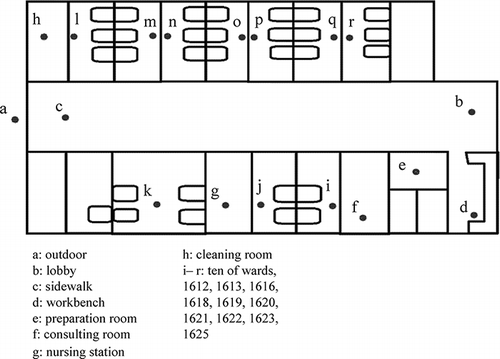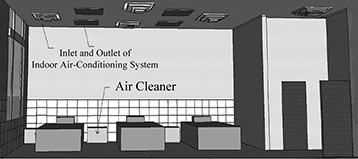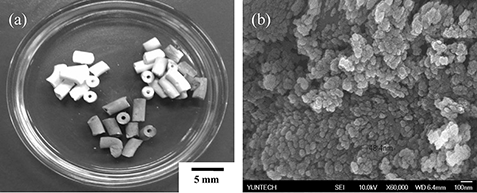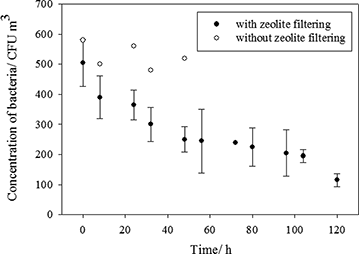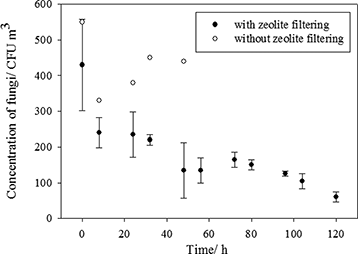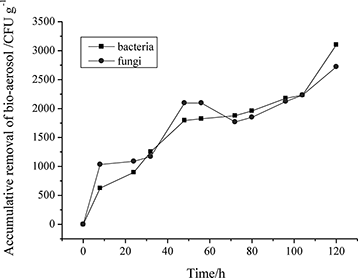Abstract
This study investigated the indoor air quality (IAQ) conditions of carbon dioxide (CO2), carbon monoxide (CO), ozone (O3), formaldehyde (HCHO), total volatile organic compounds (TVOCs), and bio-aerosols (bacteria and fungi) in a respiratory type of medical facility in Chia-Yi County in southern Taiwan. Among those IAQ conditions, the concentrations of CO, O3, and HCHO exceeded the regulation values of the Taiwan Environmental Protection Administration (EPA) mostly in the morning. The concentrations of bacteria and fungi did not exceed the regulation values but still posed potential health and environment problems for workers, patients, and visitors. Therefore, self-made silver-coated zeolite (AgZ) was used as a filter material in air cleaners to remove bio-aerosols in the respiratory care ward (RCW), and the removals were still effective after 120 hr. The cumulative bio-aerosol removals for bacteria and fungi were 900 and 1,088 colony-forming units (CFU) g−1 after 24 hr and were above 3,100 and 2,700 CFU g−1 after 120 hr. From the research results, it is suggested that AgZ filtering could be used as a feasible engineering measure for hospitals to control their bacteria and fungi parameters in IAQ management. Hospitals should maintain their environmental management and monitoring programs and use different engineering measures to improve different IAQ parameters.
Implications: This study investigated the IAQ conditions in the field at a hospital in Chia-Yi County in southern Taiwan. Although concentrations of most parameters were still within the regulation values, the concentrations of CO, O3, and HCHO were partially exceeded. We propose a method using an air cleaner with silver-coated zeolite (AgZ) as a possible engineering measure, and there were effective reductions of bacteria and fungi to lower levels with antibacterial effects after 120 hr. Furthermore, this study implies that hospitals should continuously maintain environmental monitoring programs and adopt optimal engineering measures for different needs.
Introduction
Indoor air quality (IAQ) is becoming a measurable quantity affecting human health as people drastically increased their indoor activities (Höppe and Martinac, 1998; CitationLee et al., 2002). Several common indexes of IAQ include the concentrations of carbon dioxide (CO2), carbon monoxide (CO), formaldehyde (HCHO), total volatile organic compounds (TVOCs), bio-aerosols (bacteria and fungi), PM10, PM2.5, ozone (O3), and temperature (CitationChiang and Lai, 2002). The Environmental Protection Administration (EPA) of Taiwan first announced recommended values for IAQ for public areas such as schools, medical facilities, and department stores in 2005. The values were redefined and promulgated into regulations in November 2011, and these regulations were put into effect in 2013. For IAQ in public areas, medical facilities have received a lot of attention and should be improved because many infectious diseases, such as severe acute respiratory syndrome and influenza have been found to promulgate rapidly (CitationLiu et al., 2005). Therefore, development of technology to properly control or improve IAQ in medical facilities, especially respiratory-related areas, has become the focus to protect medical personnel, patients, and visitors.
Zeolites with nano- and multiporous structures and excellent adsorption ability have been widely studied for their applications in improving IAQ (CitationMeininghaus and Prins, 2000; CitationIchiura et al., 2003; CitationYuranov et al., 2005; CitationCheng et al., 2012). To improve treatment efficiencies, adsorption by activated carbons (CitationRong et al., 2002; CitationLi et al., 2011), carbon nanotubes (CitationGuan and Yao, 2010), photocatalysis (CitationSung et al., 2011), and other methods (CitationRezaee et al., 2011) are usually used to compare with zeolites. In addition, zeolites can be combined with metal catalysts as bactericides to enhance antibacterial properties and to decrease the concentration of bacteria and fungi, especially with silver (CitationInoue et al., 2002; CitationMorrison et al., 2006; Z. Y. CitationZhang et al., 2008; CitationWang et al., 2012). The common methods for preparation of silver-coated zeolite are impregnation and ion-exchange processes (CitationZhai et al., 2000). The impregnation method is widely applied to prepare various catalysts, and the ion-exchange process is used for supports having ion-exchange ability. In addition, investigations revealed that absorption capacity and antibacterial efficiency of silver-coated zeolite could persist for several tests and be regenerated by heating without disintegration or safety concerns (CitationCheng et al., 2012; CitationWang et al., 2012).
Many previous works on indoor air pollutant control were laboratory-scale experiments rather than field studies. Thus, this study investigated the IAQ conditions of a respiratory care ward (RCW) at a hospital in Chia-Yi County in southern Taiwan in the field. The investigation results were compared with EPA regulations to understand the IAQ management status. In addition, the self-made silver-coated zeolite (AgZ) was prepared and used as a filter material to evaluate its effects on IAQ improvement, especially the long-term performance of bio-aerosols removal.
Experimental Methods
AgZ preparation and characterization
AgZ preparation procedures were developed in previous studies (CitationCheng et al., 2012; CitationWang et al., 2012). The procedures include mixing, gelling, forming, drying, and calcining of chemicals to form zeolite and impregnate them with silver. Sodium aluminate and silica as raw materials were used for Y-type zeolite synthesis. The sodium aluminate was mixed with silica and well stirred in a sodium hydroxide (NaOH) solution. The colloidal mixer was put into the extruding machine. The extruded products were dried at 105°C for 8 hr and calcined at 450°C for 8 hr. Subsequently, the raw zeolite (RZ) was obtained. The RZ was impregnated into 1 wt% of silver nitrate (AgNO3) solution and the suspension was stirred at room temperature in the dark for 24 hr. Then, drying and calcination were performed a second time and the 1 wt% AgZ was obtained.
The material properties of the AgZ were characterized. The surfaces and elementary composition of AgZ were analyzed by scanning electron microscopy (SEM, JEOL 5410LV, Tokyo, Japan) and energy-dispersive spectrometry. X-ray diffraction (Siemens D5000, Munich, Germany) was used to identify the phase structure. The specific surface area of AgZ and its average pore size were measured using the Brunauer-Emmett-Teller method (Quantachrome Autosorb-1, Florida, MA). Inductively coupled plasma–optical emission spectrometry (Perkin-Elmer Optima 5100DV, Waltham, MA) was used to determine the silver composition of AgZ. The average value of zeta potential was recorded at pH values of 3–11 using a Zeta-Meter 4.0 (Staunton, VA) over 20 measurements to reduce the effect of particle size and distribution (CitationCheng et al., 2012; CitationWang et al., 2012).
IAQ monitoring
The various IAQ parameters were investigated by monitoring and sampling at different locations in the RCW in the morning and afternoon from January 19 to 21, 2011. Each IAQ parameter in each location was measured on the same day. The interior regions (cross section) of the RCW are shown in , including the lobby (37.6 m3), sidewalk (13 m3), workbench (108.8 m3), preparation room (63.3 m3), consulting room (81.3 m3), nursing station (81.3 m3), cleaning room (50.5 m3), and 10 wards (80–100 m3). The RCW is a special care area for patients with respiratory diseases with personnel access control. It has its own air-conditioning system. Hence, the influence of ventilation and personnel from other parts of the hospital was limited. This means that IAQ sampling in the RCW was performed in a controllable environment.
The parameters monitored included temperature, relative humidity, CO2, CO, O3, HCHO, and TVOC and bacteria and fungi were sampled. Temperature, relative humidity, CO, CO2, and O3 were measured using AirBoxx monitor equipment (KD Engineering Co., Burna by, BC, Canada). TVOCs and HCHO were detected using a portable VOC monitor (ppbRAE 3000, RAE Systems, Inc. San Jose, CA) and formaldehyde was detected using a Formaldemeter Htv (PPM Technology Ltd., Wales, United Kingdom). In order to obtain the concentration of bio-aerosols, a microbial air monitoring system (MAS-100, Merck KGaA, Darmstadt, Germany) was used to capture bio-aerosols from the air and deposit them on a suitable medium for later cultivation. Aerosol sampling was executed at a height from the floor of 1.2–1.5 m. The bacteria and fungi were cultivated and detected by Cheng et al. (2012) and Wang et al. (2012). The concentration of bio-aerosols was measured, and total plate count was calculated in colony-forming units (CFUs).
Antibacterial experiments
In order to test the antibacterial performance of AgZ, bio-aerosol removal experiments were carried out in a ward with an area of 80 m3, as shown in . One hundred fifty grams of AgZ as filter was filled into an air cleaner to enhance the filtration and adsorption capability of the air cleaner to remove bio-aerosols with the antibacterial action of the AgZ. The concentrations of bio-aerosols were observed for 120 hr, and sampling was performed at 8, 24, 32, 48, 56, 72, 80, 96, 104, and 120 hr. The maximum air velocity and outlet area for the air cleaner were measured for 0.42 m sec−1 and 0.068 m2. The air exchange volume of air cleaner was calculated as 102 m3hr−1 (equal to the maximum air velocity multiplied by outlet areas). Hence, the air exchange volume of the target RCW was 478 m3 hr−1 and the indoor air-conditioning system contributed 376 m3hr−1, which was provided from hospital's general affairs office.
To avoid differences in interpretation of the experimental results from background levels, the removal efficiency of bio-aerosols by AgZ was defined as the accumulation of bio-aerosols removed per gram of AgZ (qt ) and was calculated as follows:
qt
(CFU/g) = , (1) where Q is the air exchange volume (m3/ h); ΔC is the difference in the concentration of bio-aerosols (CFU/m3); Δt is the interval time between two samplings (hr); and m is the dosage of AgZ (g).
Results and Discussion
Characterization of AgZ
The cropped RZ and AgZ () were ground to a particle size of 100 mesh and then analyzed using several instruments. The size of AgZ was about 40–60 nm as observed by SEM (). The average surface areas of RZ and AgZ were 231 and 216 m2/g. The reduction in specific surface area was caused due to the impregnated silver particles covering the pores (CitationWang et al., 2012). The elemental analyses of RZ and AgZ included aluminum (Al), silica (Si), sodium (Na), and silver (Ag), as noted in . There were slight decreases in the element composition of Al, Si, and Na after impregnation. This observation seemed to indicate an ion exchange between Ag and original elements in RZ (CitationCheng et al., 2012). X-ray diffraction was used to identify the form of Ag catalyst on the AgZ surface, and characteristic peaks of Ag appeared at 2θ values of about 38, 44, and 65°, corresponding to (111), (200), and (220) in the crystalline planes of cubic Ag (JCPDS cards 4-0783; CitationChau et al., 2005; CitationKhanna et al., 2005; CitationWang et al., 2012). In sum, the composite AgZ produced by impregnation method successfully coated the surface with silver.
Table 1. Element composition of RZ and AgZ
The IAQ conditions in the RCW
The RCW is a special care unit for patients with respiratory diseases and it should meet the EPA regulations for IAQ. Our study sampled and monitored IAQ conditions in the mornings and afternoons in various locations for all areas of the RCW. The temperature and relative humidity in the indoor environment of the RCW were 25 ± 2°C and 55 ± 5% and the temperature and relative humidity in the outdoor environment were 15 ± 2°C and 75 ± 5%. Several IAQ parameters and corresponding regulation values are shown in . Common trends of higher values observed in the morning might be related to various personnel activities. However, those observations were not confirmed due to a lack of information.
Figure 4. IAQ parameters and EPA of Taiwan regulation values in CRW locations: (a) CO2; (b) CO; (c) O3; (d) HCHO; (e) TVOCs; (f) bacteria; and (g) fungi.
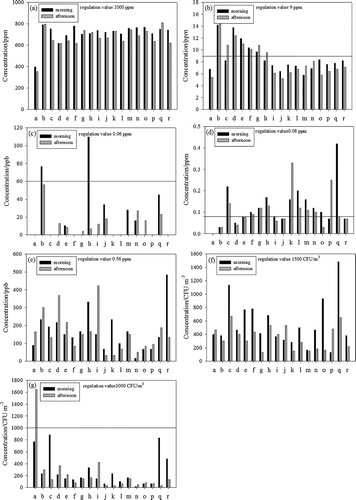
shows the common trends of higher CO2 concentrations in many locations and occasions with average concentrations of 710 ± 50 ppm. The indoor CO2 concentration was 710 ± 50 ppm, while CO2 concentration in outdoor environment was 375 ± 30 ppm. There was nearly half of concentration difference between indoor and outdoor environments. This was probably due to the positive relationship with the number of people in the area (CitationWan et al., 2011). Although CO2 concentrations in this study did not exceed the EPA's regulation values, it might be a concern for of fresh air ventilation requirements. Due to the low regulation value of CO, the concentrations were exceeded in some locations during our monitoring program (). O3 generation mechanisms in the indoor environment were reported by CitationWeschler (2000), including the effects of outdoor ozone concentration, air exchange volumes, indoor emission rates, surface removal rates, and reactions between O3 and other chemicals in the air. Therefore, O3 concentrations varied significantly from room to room and location to location, as shown in . shows higher values of HCHO concentration in the indoor areas than in the outdoor environment. This might be related to the use of antibacterial disinfectants with low air exchanges (CitationGhasemkhani et al., 2005). The measurements in the study were similar in magnitude to those found for a hospital in Guangzhou, China (CitationLü et al., 2006) and two major hospitals in Fortaleza, Brazil (CitationSousa et al., 2011). However, the measurements were lower than those found in another study of a public hospital in Brazil (CitationSodré et al., 2008). TVOC concentrations were thought to be related to antibacterial disinfection, but they did not exceed the regulation values (). Higher bacterial concentrations occurred in public areas such as sidewalks, treating areas (consulting and preparation rooms), cleaning rooms, and some wards (see locations c, e, f, h, and others in ). The average bacteria concentration in the whole RCW was 460 CFU/m3, and this measurement was similar to those found in previous research at a medical center in Taiwan (CitationTang and Wan, 2013). The highest concentration of fungi was found in the outdoor environment, as shown in . The bacterial and fungi concentrations did not exceed the regulation values, but the health risks posed by bacteria and fungi require further environmental monitoring and improvement.
From the above results, it was found that the prime indoor air-conditioning system could not effectively meet the IAQ regulations. Therefore, AgZ as the adsorbent and filter was applied to improve the IAQ parameters in the RCW, especially bacterial and fungi.
Antibacterial test to remove bio-aerosols by AgZ
The antibacterial efficiencies of RZ and AgZ were studied in laboratory-scale experiments and reported in earlier research works (CitationCheng et al., 2012; CitationWang et al., 2012). The silver catalyst on the zeolite surface could enhance the removal of bacteria and fungi, as verified in previous research (S. CitationZhang et al., 2004; CitationMorrison et al., 2006). In the RCW, 150 g of AgZ was filled into the filter chamber of an air cleaner and the air cleaner was continuously operated for 120 hr. The changes in concentrations of bacteria and fungi were monitored at different times as shown in and , respectively. The bio-aerosols concentration showed no observable decrease without the air filter. However, the air cleaner filled with AgZ resulted in higher removals of bacteria and fungi. The concentrations of bacteria decreased gradually with increasing air cleaner operation time (), and fungi concentrations showed a larger decrease after 8 hr (). Those removals were still effective after 120 hr. In addition, the change in CO2 concentrations was measured simultaneously but was insignificant.
The cumulative bio-aerosol removals were calculated and are shown in . The cumulative bio-aerosol removal for bacteria and fungi were 900 and 1,088 CFU g−1 after 24 hr, reaching above 3,100 and 2,700 CFU g−1 after 120 hr. Although AgZ exhibited good removal for bio-aerosols, the reduction mechanism was not investigated. Nevertheless, previous research showed that two isoelectric points (IEPs; at pH 4.3 and 8.5) on the RZ and AgZ surfaces were formed by the structures of amphoteric metals Al and Si. It possibly caused the second IEP shifting due to adsorption of bio-aerosols on the used AgZ surface. The shift of the second IEP on AgZ was confirmed by adsorption tests using negatively charged Escherichia coli (CitationWang et al., 2012). The major mechanisms of bio-aerosol reduction included both filtration and adsorption by zeolite and the air cleaner, as well as some minor mechanism in combination with antibacterial action by the silver coating.
Conclusion
Due to an increase human indoor activities and health protection needs, IAQ control and improvement technology has become imperative, especially for medical facilities. Our study monitored the IAQ of RCW areas in a hospital, including parameters of temperature, humidity, CO2, CO, O3, HCHO, TVOC, bacteria and fungi. A common trend of higher values was observed mostly in the morning, which might be related to various personnel activities. CO2 concentrations were higher in many locations, with an average concentration of 710 ± 50 ppm. CO concentrations were exceeded in some locations, and O3 concentrations varied significantly in RCW areas. Higher HCHO concentrations were found in indoor areas due to the use of antibacterial disinfectants. Higher bacterial concentrations occurred in public areas such as sidewalks, treating areas (consulting and preparation rooms), cleaning rooms, and some wards. Although CO2, bacteria, and fungi concentrations were within the regulation values, they could pose health and environmental problems for workers, patients, and visitors. Therefore, bacteria and fungi should receive further environmental monitoring and improvement. In the experiments on bio-aerosols removal, 150 g AgZ as filter material was filled into the filter chamber of an air cleaner(s) and the air cleaner was continuously operated for 120 hr in the RCW. The results indicated that AgZ could continue effectively reduce bacteria and fungi concentrations to below EPA regulation levels even after 120 hr with cumulative removals above 3,100 and 2,700 CFU g−1, respectively. The AgZ exhibited good bio-aerosol removal and the mechanism might be adsorption of bacteria onto the AgZ surface. In future work, we will continue the study to compare antibacterial efficiencies and pressure drop using HEPA, active carbon, and others methods. We suggest that AgZ filtering can be used as a feasible engineering measure for hospitals to control bacteria and fungi levels in IAQ management. In the meantime, hospitals should continuously maintain their IAQ conditions through environmental monitoring programs and adopt optimal engineering measures for different needs, such as in RCWs.
Funding
The authors thank the Ministry of Economic Affairs, Taiwan (98-EC-17-A-10-S1-113), for partial financial support. Thanks also to Tzu Chi General Hospital for partial support in IAQ monitoring.
Acknowledgment
Assistance from Professor Chu-Chin Hsieh and his research group in the preparation of AgZ is gratefully acknowledged.
References
- Chau , J.L.H. , Hsu , M.K. , Hsieh , C.C. and Kao , C.C. 2005 . Microwave Plasma Synthesis of Silver Nanopowders . Mater. Lett. , 59(8–9) : 905 – 908 . doi: 10.1016/j.matlet.2004.10.068
- Cheng , H.H. , Hsieh , C.C. and Tsai , C.H. 2012 . Antibacterial and Regenerated Characteristics of Ag-Zeolite for Removing Bio-Aerosols in Indoor Environment . Aerosol Air Qual. Res , 12 : 409 – 419 .
- Chiang , C.M. and Lai , C.M. A . 2002 . Study on the Comprehensive Indicator of Indoor Environment Assessment for Occupants’ Health in Taiwan . Build. Environ , 37 : 387 – 392 . doi: 10.1016/S0360-1323(01)00034-8
- Environmental Analysis Laboratory . 2008 . (EPA, Executive Yuan), Taiwan . Detection method of concentration of bacteria in the air , http://www.niea.gov.tw/analysis/method/m_n_1.asp?m_niea=E301.13C (accessed February 15, 2009)
- Environmental Analysis Laboratory . 2008 . (EPA, Executive Yuan), Taiwan . Detection method of concentration of bacteria in the air , http://www.niea.gov.tw/analysis/method/m_n_1.asp?m_niea=E401.13C (accessed February 15, 2009)
- Ghasemkhani , M. , Jahanpeyma , F. and Formaldehyde , Azam, K. 2005 . Exposure in Some Educational Hospitals of Tehran . Ind. Health , 43 : 703 – 707 . doi: 10.2486/indhealth.43.703
- Guan , T. and Yao , M. 2010 . Use of Carbon Nanotube Filter in Removing Bio-Aerosols . J. Aerosol Sci , 41 ( 6 ) : 611 – 620 . doi: 10.1016/j.jaerosci.2010.03.002
- Höppe , P. , Indoor Climate , Martinac, I. and Air , Quality. 1998 . Int. J. Biometeorol , 42 ( 1 ) : 1 – 7 .
- Ichiura , H. , Nozaki , M. , Kitaoka , T. and Tanaka , H. 2003 . Influence of Uniformity of Zeolite Sheets Prepared Using a Papermaking Technique on VOC Adsorptivity . Adv. Environ. Res , 7 ( 4 ) : 975 – 979 . doi: 10.1016/S1093-0191(02)00057-6
- Inoue , Y. , Hoshino , M. , Takahashi , H. , Noguchi , T. , Murata , T. , Kanzaki , Y. , Hamashima , H. and Bactericidal , Sasatsu, M. 2002 . Activity of Ag–Zeolite Mediated by Reactive Oxygen Species under Aerated Conditions . J. Inorg. Biochem , 92 ( 1 ) : 37 – 42 . doi: 10.1016/S0162-0134(02)00489-0
- Khanna , P.K. , Singh , N. , Charan , S. and Viswanath , A.K. 2005 . Synthesis of Ag/Polyaniline Nanocomposite via an in situ Photo-Redox Mechanism . Mater. Chem. Phys , 92 ( 1 ) : 214 – 219 . doi: 10.1016/j.matchemphys.2005.01.011
- Lee , S.C. , Li , W.M. and Ao , C.H. 2002 . Investigation of Indoor Air Quality at Residential Homes in Hong Kong—Case Study . Atmos. Environ , 36 : 225 – 237 . doi: 10.1016/S1352-2310(01)00435-6
- Li , L. , Gao , M. , Liu , J. and Guo , X. 2011 . Removal of Airborne Microorganisms Emitted from a Wastewater Treatment Oxidation Ditch by Adsorption on Activated Carbon . J. Environ. Sci , 23 ( 5 ) : 711 – 717 . doi: 10.1016/S1001-0742(10)60466-4
- Liu , J.T. , Hammitt , J.K. , Wang , J.D. and Tsou , M.W. 2005 . Valuation of the Risk of SARS in Taiwan . Health Econ. , 14 : 83 – 91 . doi: 10.1002/hec.911
- Lü , H. , Wen , S. , Feng , Y. , Wang , X. , Bi , X. , Sheng , G. and Fu , J. 2006 . Indoorand Outdoor Carbonyl Compounds and BTEX in the Hospitals of Guangzhou, China . Sci. Total Environ. , 368 : 574 – 584 . doi: 10.1016/j.scitotenv.2006.03.044
- Meininghaus , C.K.W. and Prins , R. 2000 . Sorption of Volatile Organic Compounds on Hydrophobic Zeolites . Microporous and Mesoporous Materials , 35–36 : 349 – 365 . doi: 10.1016/S1387-1811(99)00233-4
- Morrison , M.L. , Buchanan , R.A. , Liaw , P.K. , Berry , C.J. , Brigmon , R.L. , Riester , L. , Abernathyd , H. , Jind , C. and Narayan , R.J. 2006 . Electrochemical and Antimicrobial Properties of Diamondlike Carbon–Metal Composite Films . Diam Relat Mater , 15 ( 1 ) : 138 – 146 . doi: 10.1016/j.diamond.2005.08.031
- Rezaee , A. , Ramin , M. , Ghanizadeh , G. and Nili-Ahmadabadi , A. 2011 . Adsorption of Escherichia coli Using Bone Char . J. Appl. Sci. Environ. Manag , 15 ( 1 ) : 57 – 62 .
- Rong , H. , Ryu , Z. , Zheng , J. and Zhang , Y. 2002 . Effect of Air Oxidation of Rayon-Based Activated Carbon Fibers on the Adsorption Behaviour for Formaldehyde . Carbon , 40 ( 13 ) : 2291 – 2300 . doi: 10.1016/S0008-6223(02)00109-4
- Sodré , E.D. , Corrêa , S.M. , Arbilla , G. and Principais , Marques, M. 2008 . Carbonilas no ar de Locais Públicos no Rio de Janeiro (Main carbonyls in air public places in Rio de Janeiro) . Química Nova , 31 ( 2 ) : 249 – 253 .
- Sousa , F.W. , Caracas , I.B. , Nascimento , R.F. and Cavalcante , R.M. 2011 . “ Exposure and Cancer Risk Assessment for Formaldehyde and Acetaldehyde in the Hospitals, Fortaleza-Brazil ” . In Build. Environ Vol. 2115–2120 , 46 doi:10.1016/j.buildenv.2011.04.006
- Sung , W. , Tsai , T. , Wu , M. , Wang , H. and Surampalli , R. 2011 . Removal of Indoor Airborne Bacteria by Nano-Ag/TiO2 as Photocatalyst: Feasibility Study in Museum and Nursing Institutions . J. Environ. Eng , 137 ( 3 ) : 163 – 170 . doi: 10.1061/(ASCE)EE.1943-7870.0000309
- Taiwan Environmental Protection Administration. 2009a. The detection method of atmosphere bacteria concentration.
- Taiwan Environmental Protection Administration. 2009b. The detection method of atmosphere fungi concentration.
- Tang , C.S. and Wan , G.H. 2013 . Air Quality Monitoring of the Post-Operative Recovery Room and Locations Surrounding Operating Theaters in a Medical Center in Taiwan . PloS One , 8 ( 4 ) : e61093 doi: 10.1371/journal.pone.0061093
- Wan , G.H. , Chung , F.F. and Tang , C.S. 2011 . “ Long-Term Surveillance of Air Quality in Medical Center Operating Rooms ” . In Am. J. Infect. Contr 39(4), 302–308 doi:10.1016/j.ajic.2010.07.006
- Wang , Y.S. , Shen , J.H. , Lin , J.P. , Horng , J.J. and The , TG . 2012 . and Zeta-Potential Characterization of Silver–Zeolite Composites for Anti-Bacterial Capability . Journal Thermal Analysis and Calorimetry , 111 ( 2 ) : 1443 – 1448 . doi: 10.1007/s10973-012-2493-1
- Weschler , C.J. 2000 . Ozone in Indoor Environments: Concentration and Chemistry . Indoor Air , 10 ( 4 ) : 269 – 288 . doi: 10.1034/j.1600-0668.2000.010004269.x
- Yuranov , I. , Renken , A. and Zeolite/Sintered Metal , Kiwi-Minsker, L. 2005 . Fibers Composites as Effective Structured Catalysts . Appl. Catal. Gen , 281(1–2) : 55 – 60 . doi: 10.1016/j.apcata.2004.11.012
- Zhai , Q.Z. , Qiu , S. , Xiao , F.S. , Zhang , Z.T. , Shao , C.L. and Preparation , Han, Y. 2000 . “ Characterization, and Optical Properties of the Host–Guest Nanocomposite Material Zeolite–Silver Iodide ” . In Mater. Res. Bull Vol. 35 , 59 – 73 . doi:10.1016/S0025-5408(00)00193-8
- Zhang , S. , Fu , R. , Wu , D. , Xu , W. , Ye , Q. and Preparation , Chen, Z. 2004 . and Characterization of Antibacterial Silver-Dispersed Activated . Carbon Aerogels Carbon , 42 ( 15 ) : 3209 – 3216 . doi: 10.1016/j.carbon.2004.08.004
- Zhang , Z.Y. , Shi , T.B. , Jia , C.Z. , Ji , W.J. , Chen , Y. and He , M.Y. 2008 . Adsorptive Removal of Aromatic Organosulfur Compounds over the Modified Na-Y Zeolites . Appl. Catal. B Environ , 82(1–2) : 1 – 10 . doi: 10.1016/j.apcatb.2008.01.006

